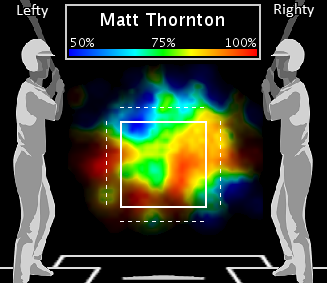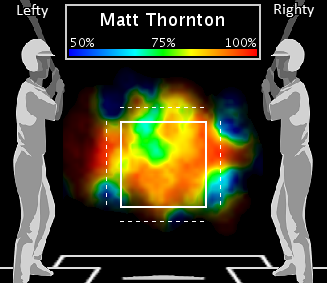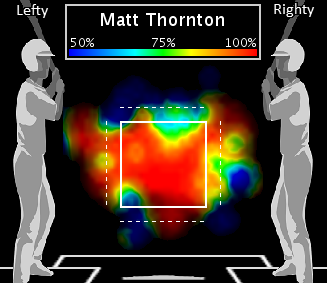Sizemore Unlikely to Beat Out Bradley Jr. for CF Job in Boston
 David Golebiewski |
David Golebiewski |  Monday, January 27, 2014 at 6:00AM
Monday, January 27, 2014 at 6:00AM
By now, Grady Sizemore was supposed to be burnishing his Hall of Fame credentials. Sizemore had it all -- power, speed, strike-zone awareness, Grady's Ladies -- and was about as valuable during his age 22 to 25 seasons (24.6 Wins Above Replacement) as Frank Robinson, Derek Jeter and Ken Griffey Jr. But today, the Indians' erstwhile franchise center fielder is merely a 31-year-old scrapping for a roster spot with the Red Sox following seven surgical procedures that have prevented him from taking the field since September 22, 2011.
What do the defending World Series champions see in Sizemore, whom they signed to a one-year, $750,000 deal that could reach $6 million if he hits performance bonuses? Where could he contribute in 2014? Here are a couple ways that Boston could deploy Sizemore, assuming he makes it through spring training in one piece.
A Jackie Bradley Jr. alternative in center field
This seems to be the angle that's getting the most play in the media. Boston, looking to replace new Yankee Jacoby Ellsbury in center, might be reluctant to give an everyday job to Bradley Jr., given the 23-year-old's wretched showing in the majors last season (.189 AVG/.280 OBP/.337 SLG in 107 plate appearances). It's a sexy story ("broken down star beats out hot shot youngster"), but Sizemore likely won't be trotting out to the middle pasture come opening day.
For one thing, Bradley Jr. is still highly promising. The former South Carolina star has a career .297/.404/.471 line in the minors, blending superb plate patience with mid-range power. He's also a gazelle in center field, with MLB.com's Jim Callis dubbing Bradley the best defensive outfield prospect in the game. Sure, he was terrible in limited playing time in 2013, but it's hardly unprecedented for a top young player to flail initially and then go on to have a great career. Dustin Pedroia, for example, had an even worse showing at the plate than Bradley (.191/.258/.303 in 98 plate appearances back in 2006). When he got off to a .182/.308/.236 start in April of 2007, some were ready to cut bait. Sometimes, it takes prospects a few hundred ABs to get acclimated.
Bradley's main issue last year was contact, as he punched out in 29 percent of his plate appearances. He had a particularly difficult time squaring up high pitches (he swung and missed 27.1 percent of the time, compared to the 20.3 percent MLB average). But there's not much reason to think he'll whiff like Pedro Alvarez or Mark Reynolds moving forward -- Bradley struck out a modest 17.4 percent of the time on the farm. Chances are Bradley gets on base, drives pitches into the gaps and tracks down fly balls like a boss in 2014.
We also have no idea whether Sizemore is actually capable of playing center field at this point. Advanced defensive metrics like Ultimate Zone Rating considered him a plus fielder during his halcyon days in Cleveland (+4.3 runs saved compared to an average player per 150 games), but that was before Sizemore had microfracture surgery on both knees. Maybe he can still fly, or maybe he gimps around like Kirk Gibson in the '88 World Series. We won't know until he takes the field.
Jonny Gomes' platoon partner in left field
This scenario looks more plausible, though Daniel Nava is more deserving as a guy who thumps righties (.303/.401/.459 in 2012-13) and isn't coming off a two-year respite. Gomes obliterates left-handed pitching (.277/.387/.494 over the past three seasons) but gets shut down by righties (.205/.314/.382). He also plays defense like a guy who had microfracture surgery yesterday. Sizemore, meanwhile, still managed to inflict some damage versus right-handers while his body betrayed him (.254/.333/.450 from 2009-11). A Sizemore-Gomes platoon could be productive. Of course, a Nava-Gomes platoon is already productive.
Mike Carp also hits righties pretty well (.258/.333/.449 from 2011-13). He could be swapped, though I wouldn't bet on GM Ben Cherington showing that much faith in Sizemore's durability.
Sizemore's role in Boston is about what you'd expect for a guy who hasn't seen live pitching since beer-and-chicken-gate -- he doesn't really have one right now. He could contribute, and he has far more upside than your typical 30-something scrapheap sign. Still, nobody's counting on him to crack the opening day roster, much less usurp a top prospect like Bradley.
 Indians,
Indians,  Red Sox | tagged
Red Sox | tagged  Ben Cherington,
Ben Cherington,  Boston Red Sox,
Boston Red Sox,  Cleveland Indians,
Cleveland Indians,  Daniel Nava,
Daniel Nava,  Grady Sizemore,
Grady Sizemore,  Jackie Bradley Jr.,
Jackie Bradley Jr.,  Jonny Gomes,
Jonny Gomes,  Mike Carp,
Mike Carp,  injuries
injuries



